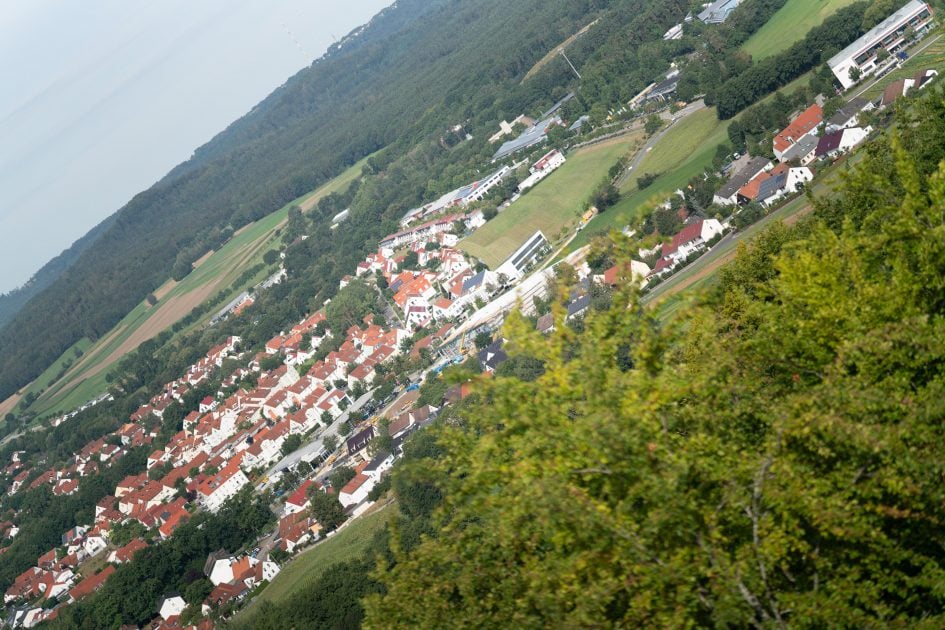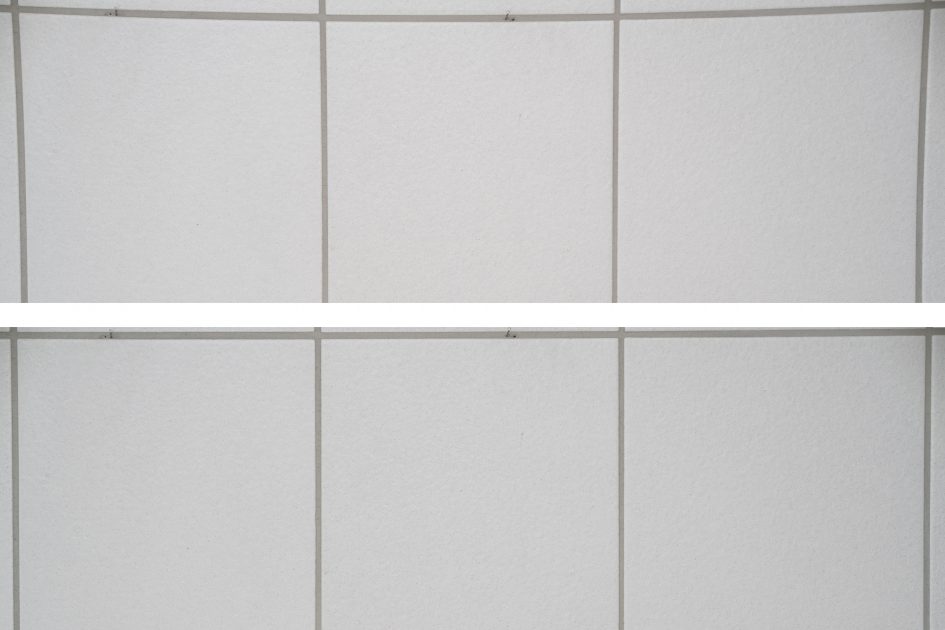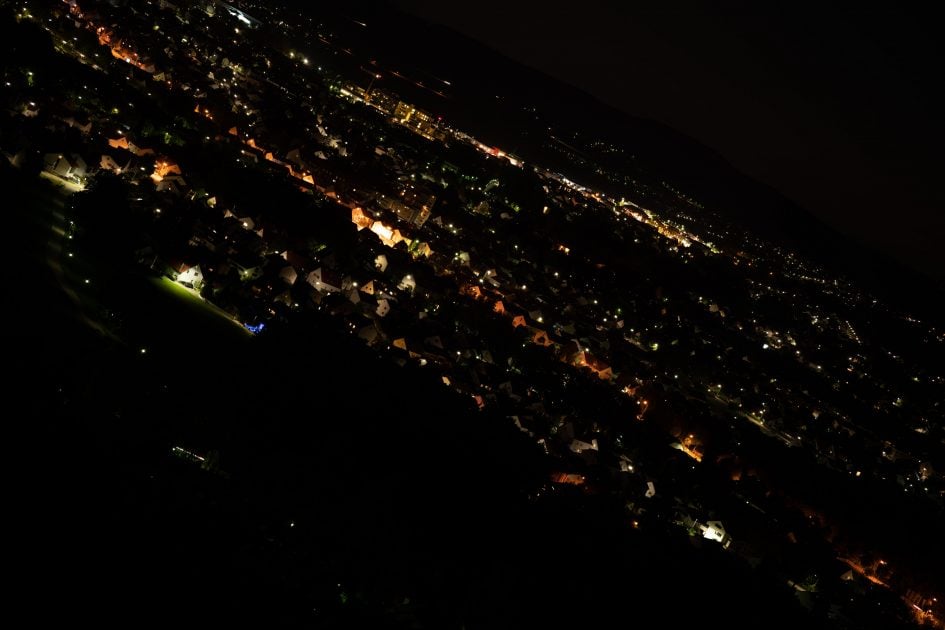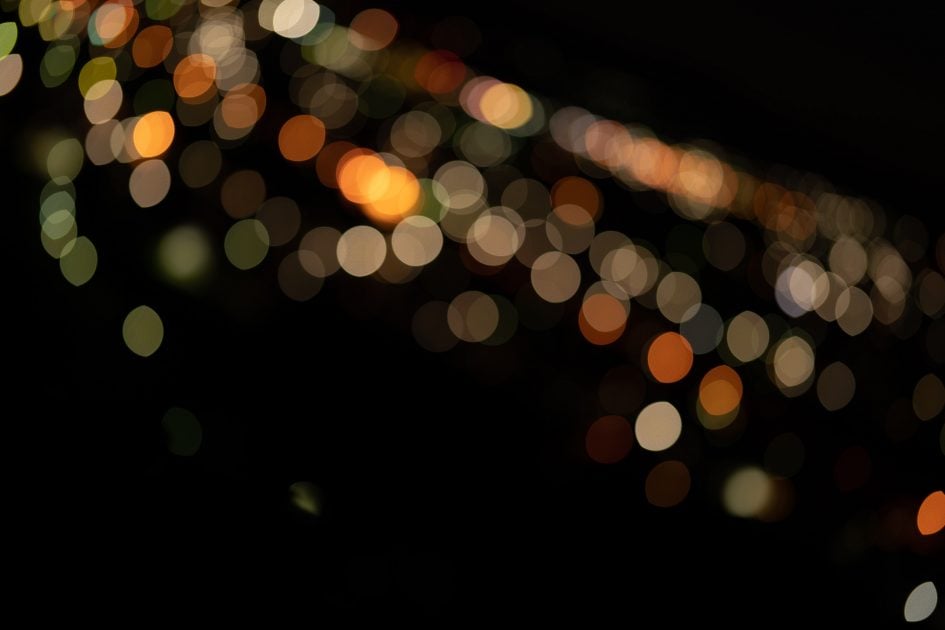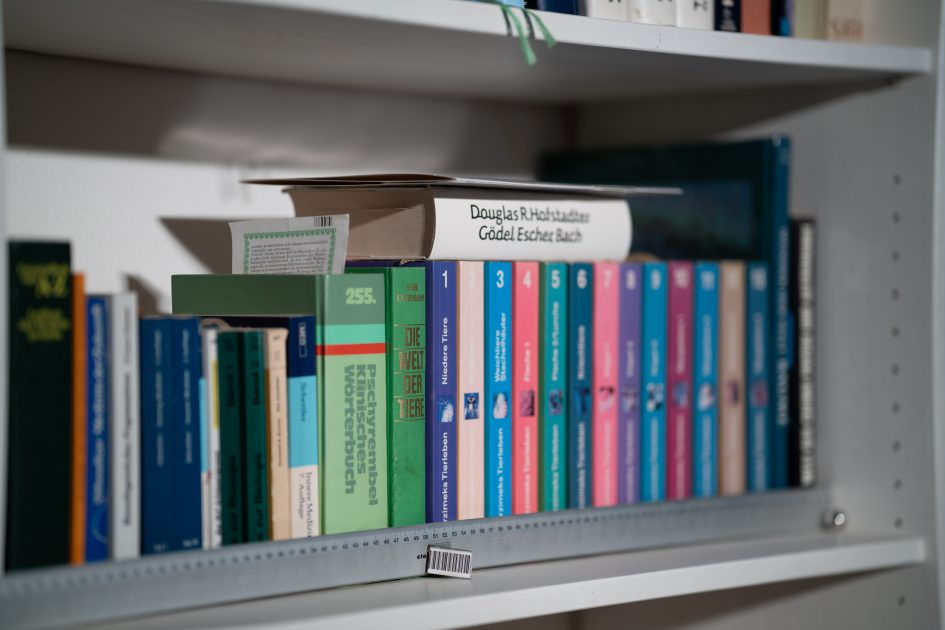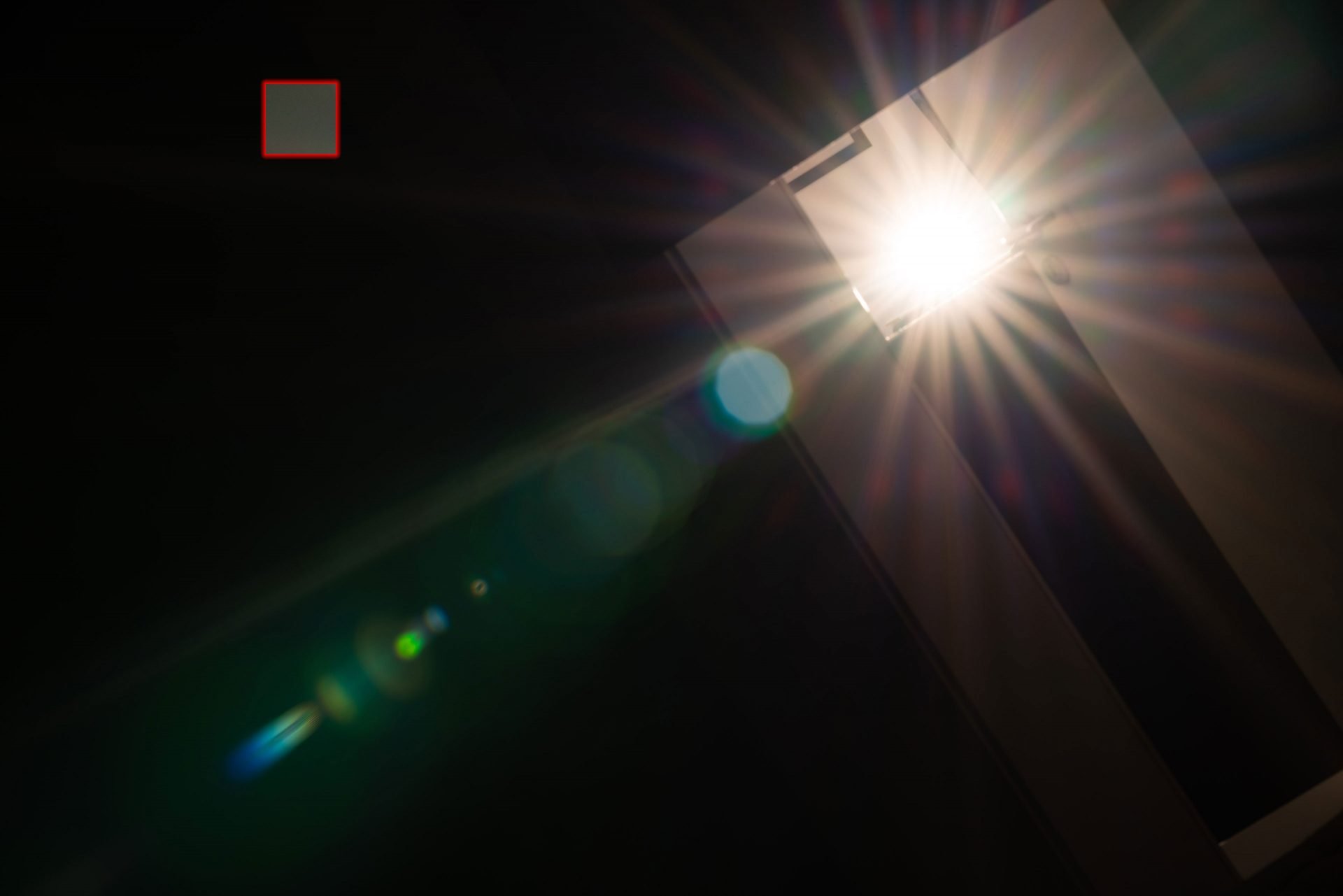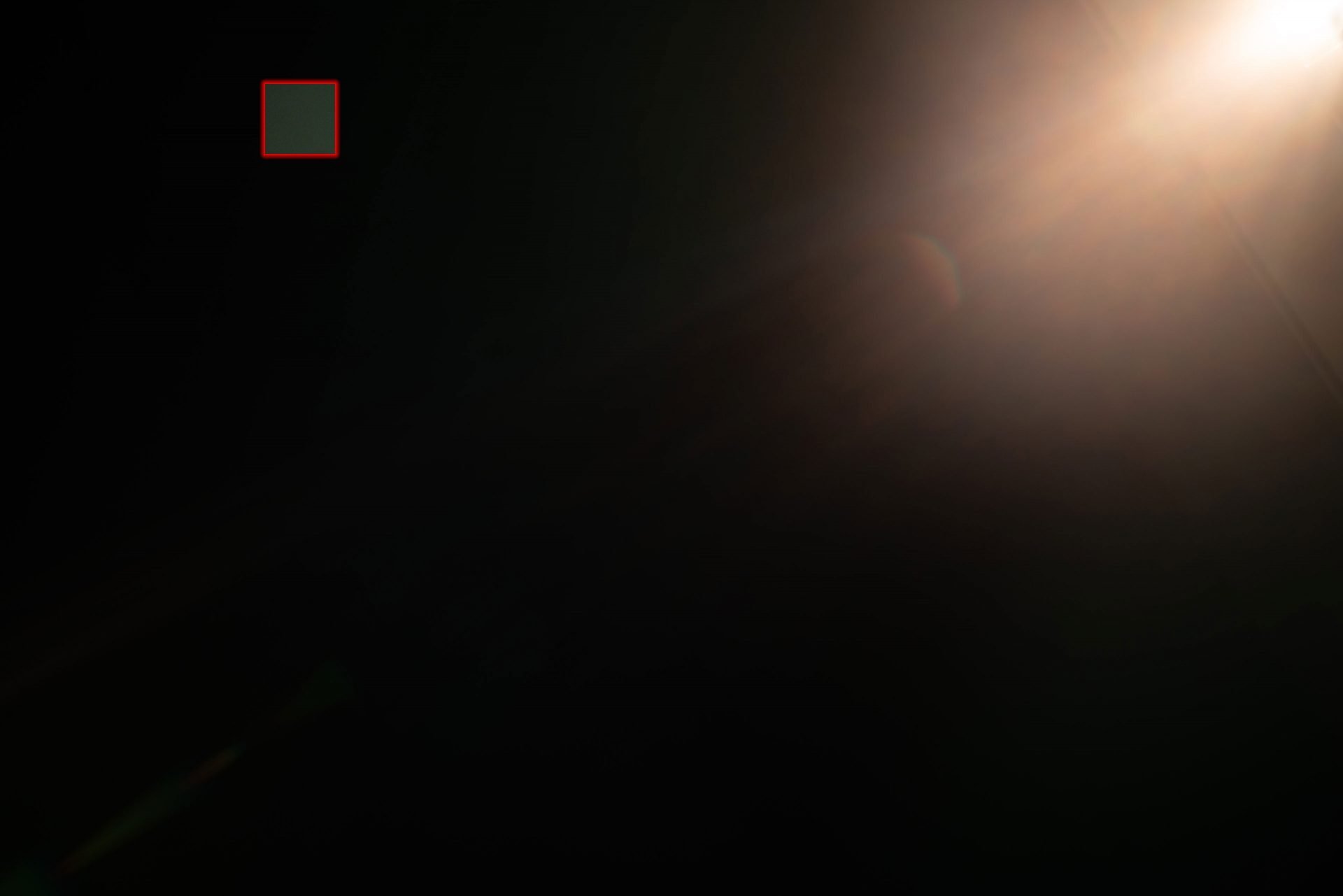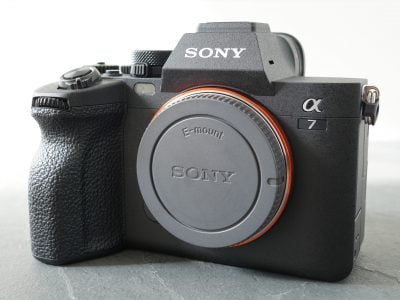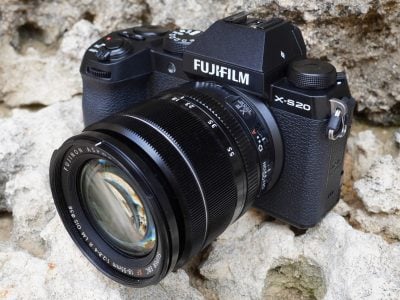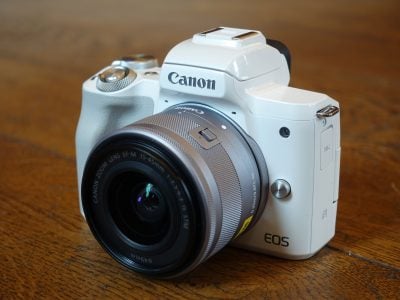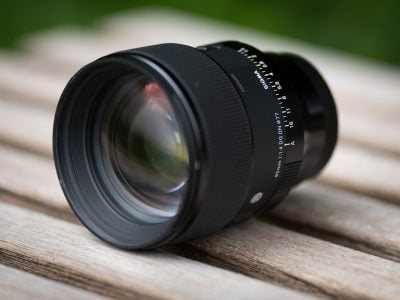Sigma 85mm f1.4 DG DN Art review
-
-
Written by Thomas
Quality
Testing: Longitudinal Chromatic Aberration and focus shift
Lenses with focal ratios of f2.8 or larger are often prone to longitudinal color aberrations (loCA, a.k.a. “axial color” or “bokeh CA”). These show up as magenta coloration in the foreground and greenish hues in the background and are not easily corrected in post-processing. The Sigma 85mm f1.4 DG DN Art has only mild loCA and there’s also no focus shift.
Sigma 85mm f1.4 DG DN Art longitudinal Chromatic Aberration (loCA)
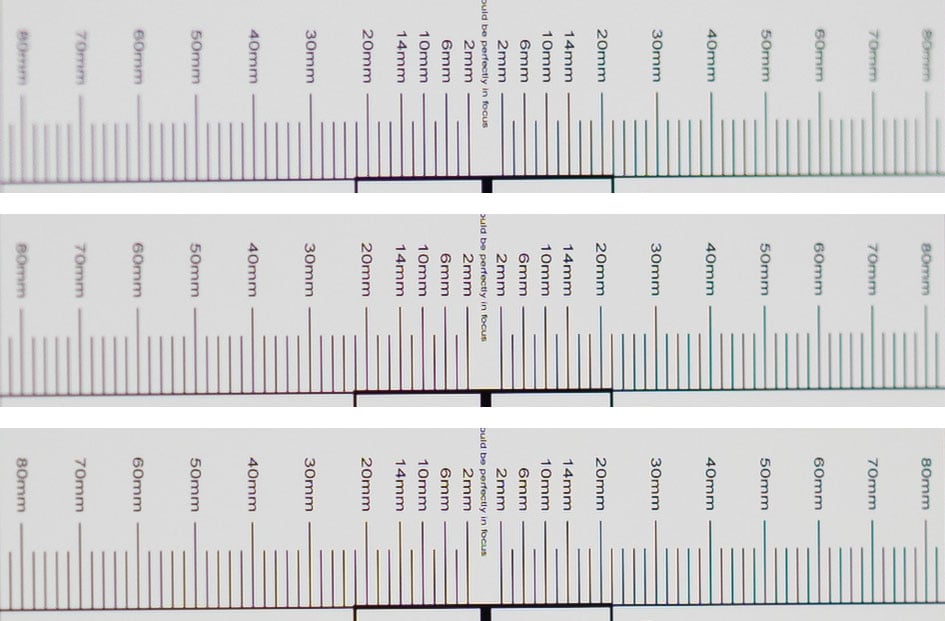
100% crops from top to bottom: f1.4, f2.0, f2.8; left = foreground, right = background
The Sony in comparison shows clearly stronger loCA (see here) while both the Zeiss 85mm f1.4 Otus (here) and Sigma 85mm f1.4 DG HSM Art (here) look similar to the new Sigma.
The following real life shot shows that the Sigma 85mm f1.4 DG DN Art produces only a bit of purple fringing around high-contrast edges in the focal plane or green outlining around background subjects:
Above: Sigma 85mm f1.4 DG DN Art at f1.4, 100% crop, click image for 4k version, here for large original
And there’s almost no coloration around specular highlights as the image of the fountain on the samples page shows.
Sharpness and contrast
Let’s have a look at the theoretical performance of the Sigma 85mm f1.4 DG DN Art first and compare it to the Sigma 85mm f1.4 DG HSM Art and the Sony:
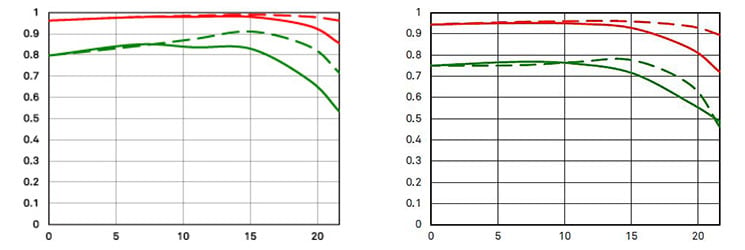
Above: Sigma 85mm f1.4 DG DN Art (left), 85mm f1.4 DG HSM Art (right)
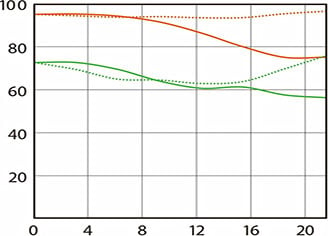
Above: Sony FE 85mm f1.4 GM
These MTF charts show the computed lens-performance of lenses wide open without influence of diffraction at 10 line-pairs/mm (red) and 30 lp/mm (green). Higher values are better (more contrast) and the closer the line-pairs are together the less astigmatism (= resolution depends on the orientation of the test-pattern) the lens has. The x-axis displays the distance from the optical axis (=center of the sensor) in mm. I’ll show you the real-life performance at 4 mm (center), 13 mm (APS-C-corner), and 20 mm (FF-corner) on a on a 42MP Sony A7R II camera.
From the charts the new optical construction has lifted resolution and contrast of the Sigma 85mm f1.4 DG DN Art compared to its DSLR sibling. It also should be sharper than the Sony.
Let’s see how this theoretical performance translates into real life results in the sharpness test based on Siemens-stars. Processing was done in Lightroom 9.4/CRAW 12.4 from RAW to Adobe Color profile with the built-in lens profile for Vignette Control and CA compensation applied. Noise-reduction is set to 0, sharpening to 50/0.5/36/10, with no extra tone, color, or saturation adjustment. White-balance was adjusted to a neutral white and I did some exposure compensation to make the brightness of all crops match. So you will not see light fall-off in the corners.
The following 100% crops show the new Sigma 85mm f1.4 DG DN Art compared to the Sony FE 85mm f1.4 GM, Sigma 85mm f1.4 DG HSM Art (shot on a 36MP Nikon D810), and Zeiss 85mm f1.4 Otus (shot on a 45MP Nikon D850) at f1.4. The D850 has a 4% higher, the D810 7% lower linear resolution than the Sony A7R II. But these differences are practically irrelevant for judging resolution.
Sigma 85mm f1.4 DG DN Art; 100% crop from center, APS-C-corner, FF-corner

Above: Sigma 85mm f1.4 DG DN Art at f1.4

Above: Sony FE 85mm f1.4 GM at f1.4; also available at f2.0, f2.8, f4.0, f5.6, f8.0, f11

Above: Sigma 85mm f1.4 DG HSM Art on a 36MP Nikon D810 at f1.4; also available at f2.0, f2.8, f4.0, f5.6, f8.0, f11

Above: Zeiss 85mm f1.4 Otus on a 46MP Nikon D850 at f1.4; also available at f2.0, f2.8, f4.0, f5.6, f8.0, f11
In this comparison at f1.4 the new Sigma DN is clearly the sharpest lens across the sensor even beating the Zeiss Otus which is my reference lens in this class. Be warned though that this result may err a bit on the positive side as my test-copy of the lens was a little decentered. This might have helped the corner I’m showing here as the opposite corner was a bit weaker. There’s also some field curvature at this object distance which made it necessary to re-focus for optimal corner sharpness. Still: this performance is very impressive!
Now let’s see how the Sigma 85mm f1.4 DG DN Art develops when stopped down:

Above: Sigma 85mm f1.4 DG DN Art at f2.0

Above: Sigma 85mm f1.4 DG DN Art at f2.8

Above: Sigma 85mm f1.4 DG DN Art at f4.0

Above: Sigma 85mm f1.4 DG DN Art at f5.6

Above: Sigma 85mm f1.4 DG DN Art at f8.0

Above: Sigma 85mm f1.4 DG DN Art at f11
As performance at f1.4 was already excellent stopping Sigma’s 85mm f1.4 DG DN Art down does not really bring much benefit. Except that field-curvature becomes less critical. And at f11 softening from diffraction sets in.
Performance at long distances
The Siemens-star test-targets are shot at a distance of 45x focal length (i.e. at around 4m). But performance of lenses also depends on the shooting distance. Therefore I present another series of test-shots of a city around 1 km away. Processing was done in Lightroom 9.4/CRAW 12.4 from RAW to Adobe Color profile with the built-in lens profile compensating CA. I also dialed in some vignette compensation to make it easier to judge sharpness in the corner. Noise-reduction is set to 0, sharpening to 50/0.5/36/10, with no extra tone, color, or saturation adjustment. I used manual focus at the largest aperture and did not change focus for other apertures. All shots were made at ISO 100 and image stabilization switched off.
The following image shows the complete scene wide open to give you an impression of the angle of view. Following the main image are 100% crops from the center, APS-C-corner, and FF-corner from the new Sigma 85mm f1.4 DG DN Art compared to the Sony FE 85mm f1.4 GM, and Zeiss 85mm f1.4 Otus (shot on a 45MP Nikon D850) at f1.4. Both the Sony and Zeiss lenses were shot another day. As usual I have selected the diagonal that provided the better corner results as almost any lens is a bit decentered.
You can access the large originals but please respect our copyright and only use those images for personal use.
Above: Sigma 85mm f1.4 DG DN Art at f1.4

Above: Sigma 85mm f1.4 DG DN Art at f1.4; 100% crops, click image for 4k version, here for large original

Above: Sony FE 85mm f1.4 GM at f1.4; 100% crop from center, APS-C-corner, FF-corner; also available at f1.7, f2.0, f2.8, f4.0, f5.6, f8.0, f11

Above: Zeiss 85mm f1.4 Otus on a 45MP Nikon Z7 at f1.4; 100% crop from center, APS-C-corner, FF-corner; also available at f1.8, f2.0, f2.8, f4.0, f5.6, f8.0, f11
In this long-distance test the Sigma85mm f1.4 DG DN Art again delivers the best results across the sensor. The Sony FE 85mm f1.4 GM is a bit softer in the APS-C corner while the Zeiss Otus shows some strange “spiky” artifacts in the FF-corner around the lettering in this shot.
Let’s see how the Sigma 85mm f1.4 DG DN Art develops when stopped down:

Above: Sigma 85mm f1.4 DG DN Art at f2.0

Above: Sigma 85mm f1.4 DG DN Art at f2.8

Above: Sigma 85mm f1.4 DG DN Art at f4.0

Above: Sigma 85mm f1.4 DG DN Art at f5.6

Above: Sigma 85mm f1.4 DG DN Art at f8.0

Above: Sigma 85mm f1.4 DG DN Art at f11
Stopping down to f2.8 brings sharpness in the FF-corner to excellent levels which makes the Sigma 85mm f1.4 DG DN Art reproduce very finely details from corner to corner.
Vignetting and distortions
To make it easier to see light fall-off in the corners of a full-frame sensor I’ve arranged a series of shots with the Sigma 85mm f1.4 DG DN Art at different apertures. All images were developed to the same brightness in the center and with the built-in lens profile compensating vignetting.
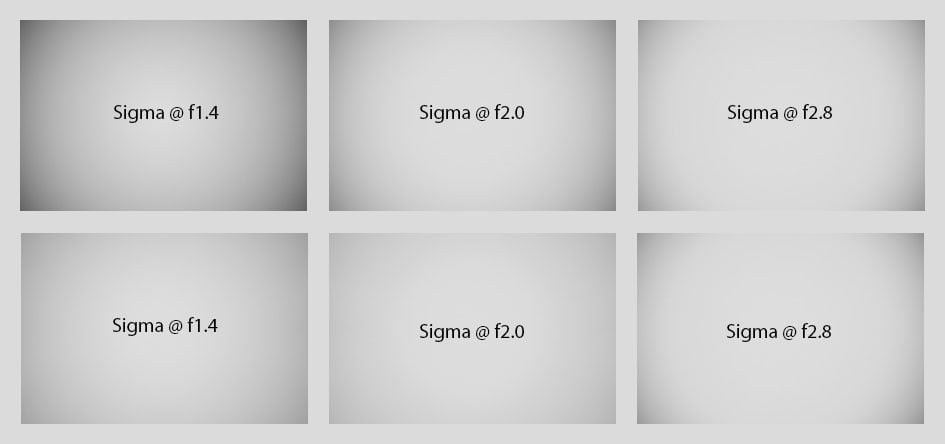
Above: Sigma 85mm f1.4 DG DN Art with shading compensation OFF (top), and shading compensation AUTO (bottom) at f1.4, f2.0, f2.8
The sample images above show that even with the lens profile applied vignetting of the new Sigma still remains visible. Automatic shading compensation lifts the extreme corners about 1 EV at f1.4. Adobe’s RAW converter automatically applies shading compensation as it was set in camera – but you cannot alter the setting in postprocessing.
Distortions are of a pretty strong pin-cushion type. The setting for distortion compensation in camera is currently ignored by Adobe’s RAW converter and treated as OFF and there is also no lens profile for the new Sigma in Lightroom 9.4 / CRAW 12.4. This hopefully gets remedied in a later version. To get rid of the distortions you have to manually dial in a compensation of -11 in Lightroom. When shooting JPGs the camera at least does a pretty good job with Sigma’s lens profile to correct for distortions:
Distortions: Sigma 85mm f1.4 DG DN Art, as is (top) / with lens-profile (bottom)
Rendering of point-light sources at night-shots
Night-shots pose a different challenge for lenses as the contrast is even higher than under bright sun and point-light sources can reveal some weaknesses such as coma, haloing and colour-aberrations that do not show up as prominently in other test-shots. The 100% crops below the main image show the effect of coma in the FF-corner of the new Sigma 85mm f1.4 DG DN Art at different apertures compared to other lenses:
Above: Sigma 85mm f1.4 DG DN Art at f1.4; click image for 4k version, here for large original

Above: Sigma 85mm f1.4 DG DN Art; 100% crops from the FF-corner at f1.4 (left), f2.0 (middle), f2.8 (right)

Above: Sony FE 85mm f1.4 GM; 100% crops from the FF-corner at f1.4 (left), f2.0 (middle), f2.8 (right)

Above: Zeiss 85mm f1.4 Otus on a 36MP Nikon D810; 100% crops from the FF-corner at f1.4 (left), f2.0 (middle), f2.8 (right)
The Sigma 85mm f1.4 DG DN Art produces very little coma even wide open. The Sony produces the strongest coma, the Zeiss Otus is somewhere in-between.
Rendering of out-of-focus point-light sources
This test is for the rendering of point-light sources in an out-of-focus background. The circle of confusion that is produced by this test is pretty indicative of Bokeh performance (in the background) and light fall-off. Ideally the out-of-focus image of the point-light is evenly lit and perfectly circular, with no “onion-rings”, and without coloration. Large aperture lenses normally produce an effect known as “cat’s eye” the further away from the optical axis the point-light is projected. This is due to optical vignetting in the lens barrel when light enters the lens from an angle.
The new Sigma is first, followed by the usual batch of comparisons.. Crops are from the center, APS-C-corner, and FF-corner resized to make them comparable across all my reviews.
Above: Sigma 85mm f1.4 DG DN Art at f1.4

Above: Sigma 85mm f1.4 DG DN Art at f1.4; click image for 4k version

Above: Sony FE 85mm f1.4 GM at f1.4; also available at f1.7, f2.0, f2.8, f4.0, f5.6, f8.0

Above: Sigma 85mm f1.4 DG HSM Art on a 36MP Nikon D810 at f1.4; also available at f1.8, f2.0, f2.8, f4.0, f5.6, f8.0

Above: Zeiss 85mm f1.4 Otus on a 36MP Nikon D810 at f1.4; also available at f1.8, f2.0, f2.8, f4.0, f5.6, f8.0
The diameter of the Bokeh balls in the center is determined by the entrance pupil of the lens – which is equal at all four 85mm f1.4 lenses. And compression of the circle towards the corners also looks quite comparable across the four lenses. The inside of the Bokeh balls is pretty smooth with only the Zeiss Otus showing some moderate onion rings. Outlining is very moderate with the lenses but you can see some green coloration from longitudinal CA on the Sony.
Now let’s see how this analysis of out-of-focus point-light sources translates into Bokeh-performance shooting a book-shelf. Crops are from the foreground, middle-ground, and background resized to make them comparable across all my reviews.
Above: Sigma 85mm f1.4 DG DN Art at f1.4
Above: Sigma 85mm f1.4 DG DN Art at f1.4; click image for 4k version, here for large original

Above: Sony FE 85mm f1.4 GM at f1.4; click image for 4k version, here for large original

Above: Sigma 85mm f1.4 DG HSM Art on a Nikon D810 at f1.4; also available at f1.8, f2.0, f2.8, f4.0, f5.6, f8.0

Above: Zeiss 85mm f1.4 Otus on a Nikon D810 at f1.4; also available at f1.8, f2.0, f2.8, f4.0, f5.6
All four lenses are very similar and you have to look closely to see some differences:
- Foreground: The new Sigma DN looks comparable to the Zeiss Otus but not as soft as the Sigma HSM. The Sony is the most nervous in the foreground.
- Middle-ground: The new Sigma DN again is pretty comparable to the Zeiss Otus and shows less coloration from loCA than the Sony. The Sigma HSM produces the softest rendering of the transition zone.
- Background: The Sony and the Sigma HSM seem to produce the softest background blur. The new Sigma DN is just a tad harsher and the Otus is a bit nervous in comparison.
All-in-all the older Sigma 85mm f1.4 DG HSM Art looks like the winner here but the others are not far behind.
Flare, ghosting, and sun-stars
Catching a strong light-source shining directly into the lens is always a risky business: it could produce strange colorful ghost-images or reduce contrast considerably through flare and glare. The appearance of flare and ghosting depends on factors like the aperture and the angle of the light hitting the lens. So to judge the proclivity of the new Sigma 85mm f1.4 DG DN Art for these artifacts I went through a series of well calculated shots against a strong light source to provoke glare and ghosting. The lens hood was mounted in all shots. Following are two of the more extreme example results. The little bright square inset in the upper left shows the respective area with an exposure compensation of +3 EV to make it easier to see which levels of black the lens renders at that point:
Above: Flare and ghosting. Strong light hitting the Sigma 85mm f1.4 DG DN Art at f11; click image for 4k version or here for +3 EV exposure compensation
Above: Flare and ghosting. Strong light hitting the Sigma 85mm f1.4 DG DN Art at f11; click image for 4k version or here for +3 EV exposure compensation
The Sigma 85mm f1.4 DG DN Art produces some ghosting artifacts and flares and overall contrast is reduced through veiling glare – although not as much as from the Sony. The flare from the upper right in the second image only occurs at a very narrow angle when the light-source is just outside the corner.
The new Sigma 85mm f1.4 DG DN Art produces well defined sunstars with 22 points already at f5.6. And the more you stop down the bigger they get:

Above: Sunstars from the Sigma 85mm f1.4 DG DN Art at f5.6 (left), f8.0 (right), 100% crops
Next check out my sample images!
Check prices on the Sigma 85mm f1.4 DG DN Art at B&H, Adorama, WEX or Calumet.de! Alternatively get yourself a copy of my In Camera book or treat me to a coffee! Thanks!
